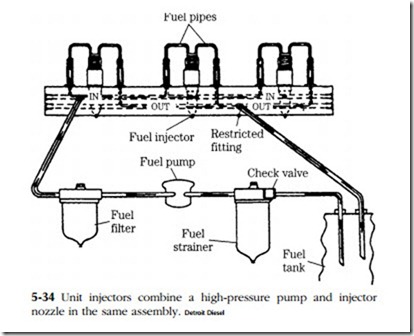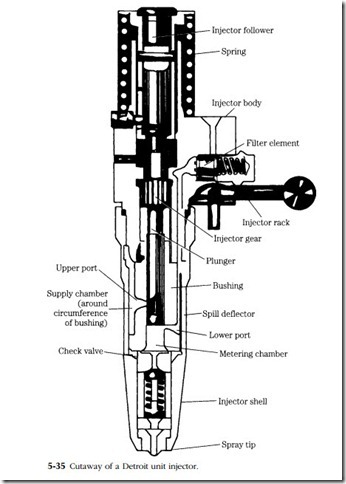Unit injection
Thus far, we have discussed three types of mechanical fuel systems: air blast, early common-rail, and jerk pump. The last of these systems, and in some ways the most attractive, is unit injection.
Unit injection combines the pumping function with injection. That is, each UI incorporates its own high-pressure pump driven from the engine camshaft. Injection
pressures, often in excess of 20,000 psi, are confined entirely within the injector bodies. The lines that connect the lift pump with the injectors see only moderate pressures, on the order of 50 psi. Consequently, UI systems are virtually leak-proof. Mechanics, at least the ones old enough to remember first-generation Volkswagens and Detroit Diesel two-strokes, like the way UIs localize problems. When a UI fails, only the associated cylinder goes out. And because an engine will run with one or two bad injectors, it becomes its own test stand.
Figure 5-34 illustrates the standard Detroit Diesel fueling circuit. The restrictor draws off a portion of the incoming fuel to cool the injectors before returning to the tank. Two stages of filtering are provided, with the primary filter on the suction side of the fuel pump.
In addition to the parts found on more conventional injectors, a UI has a mushroom- shaped cam follower, return spring, pump plunger, fuel-supply chamber, and one or more check valves (Fig. 5-35). The rack controls fuel delivery by rotating the plunger as described under “Inline pumps.”
Fuel enters the injector and passes to the supply chamber. As the engine cam forces the plunger down, fuel trapped in the supply chamber comes under increasing
pressure. At NOP, the needle valve lifts and injection begins. The disc-shaped check valve is fail-safe. Should needle fail to seat, the check valve closes to prevent air from entering the fuel supply.
Other than changing out plunger-related parts, unit injectors are not normally considered field-repairable.

